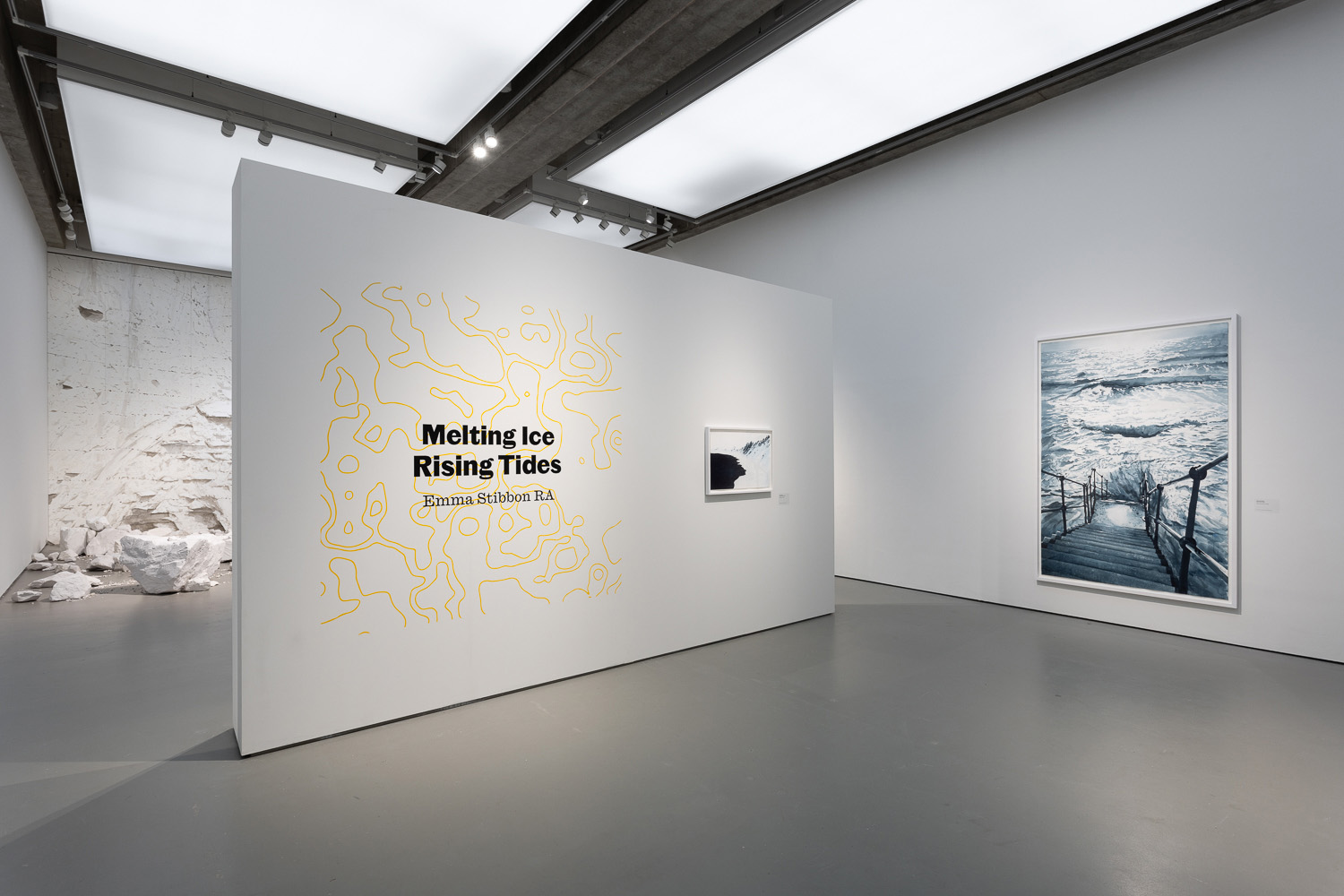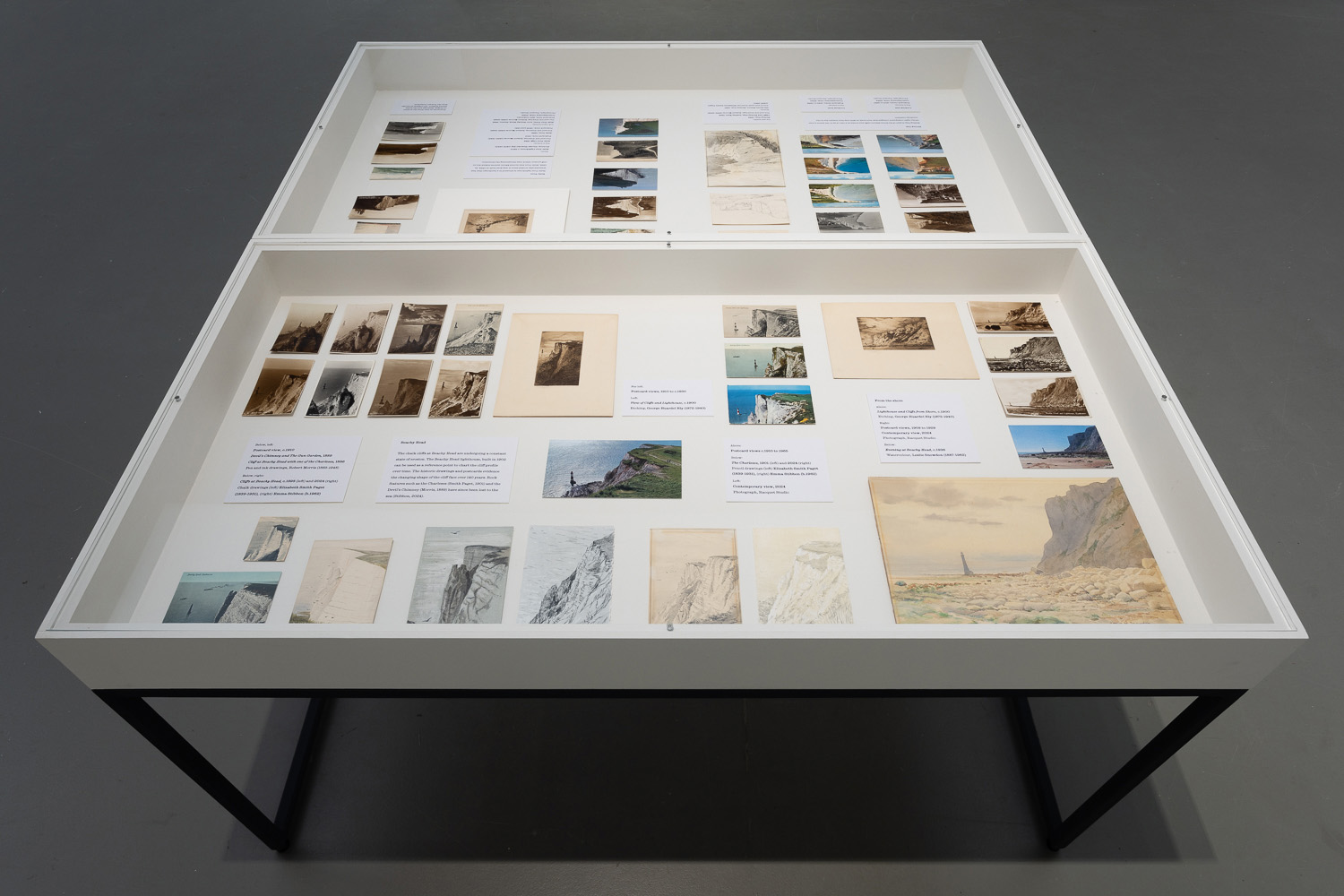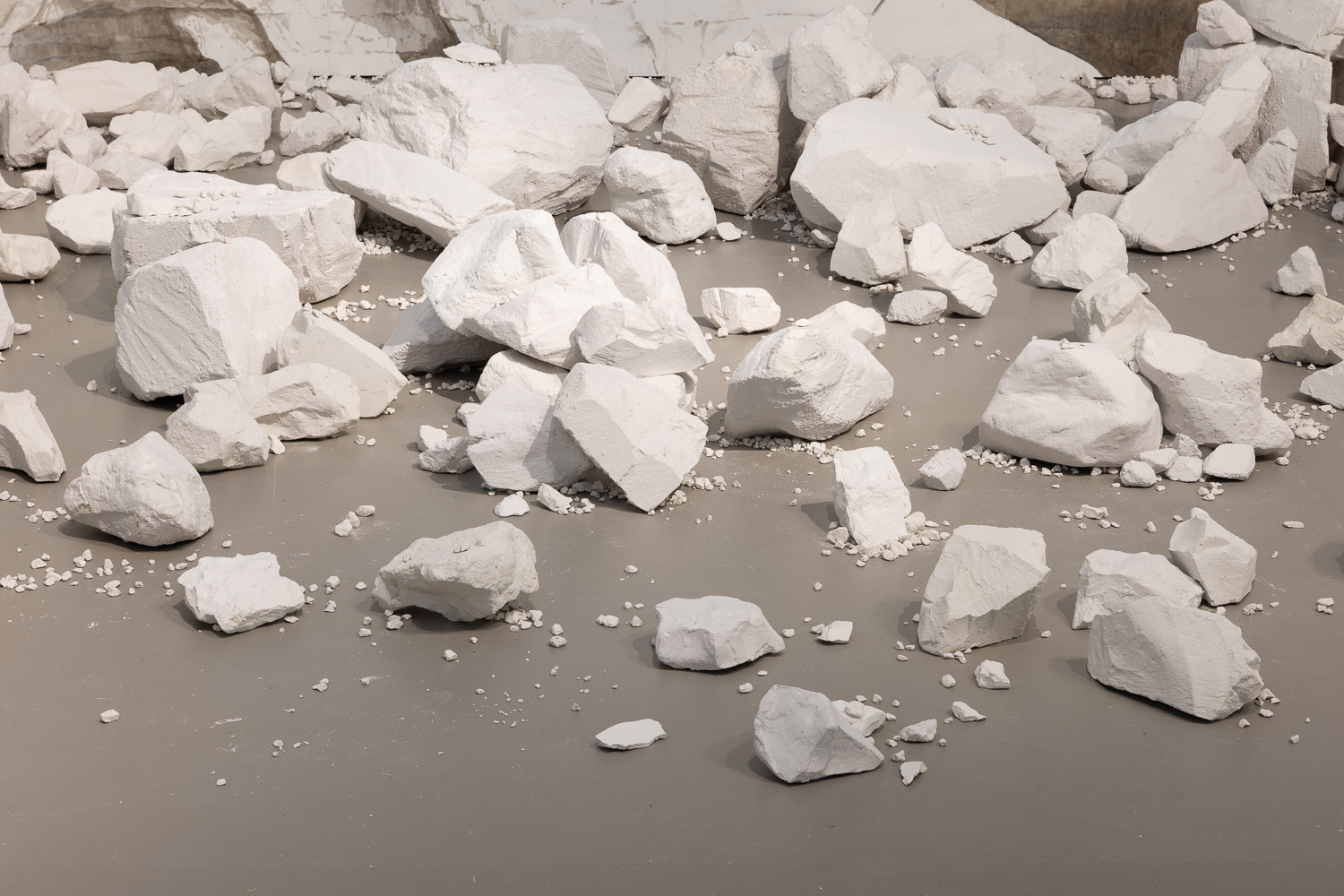Creation from collapse at Towner Eastbourne: Emma Stibbon’s shoreline
research
In her solo exhibition at Towner Eastbourne, Melting Ice | Rising Tides, artist Emma
Stibbon makes poetic connection between Sussex and Svalbard, Norway. The
coastline of each place is made differently, but both are impacted by a
changing climate. Blair Kern explored Stibbon’s research & outputs for recessed.space.
On a spring
day in Eastbourne, the beach is alive with coastal recreation. Groups of people
are arriving from the west of the town, having hiked the popular trail along
the Seven Sisters Cliffs, a journey of over 10 kilometres marked by
breathtaking views of the interface between land and sea. The sheer scale of
the imposing white cliffs, seemingly eternal, create an illusion of permanence.
Yet, viewed through a wider lens of time, these cliffs tell a different story.
Just a short walk from the ever-transforming Sussex shoreline, the contemporary art gallery, Towner Eastbourne, accelerates time and makes permanent landforms crumble in a single visit. On the third floor of the colourful community-focused gallery, the works of Emma Stibbon are exhibited in the exhibition Melting Ice | Rising Tides, where through visual research, Stibbon presents the ongoing deterioration of ice and land.
![]()
![]()
Stibbon is an artist whose works capture a series of transforming landscapes across the globe. In recent years, she has been researching the vulnerability of ice in the regions surrounding Svalbard, Norway – a landscape drastically transformed due the effects of climate change. In Melting Ice | Rising Tides, Stibbon uses works made in Svalbard as a tool to communicate the impacts of a changing climate, and therefore, demonstrating imminent risk to nearby Sussex coast. In the exhibition, Stibbon shrinks time and communicates the not-so-distant future of the Sussex coast in a local institution so intimate with the landform in question.
Upon entering the gallery, the visitor is introduced to the two regions of focus. Although the exhibition presents an intimate relationship between ice and coast, a limited connection is formed between the modest sized intaglio print of an Ice Shelf in Svalbard and a large ink drawing of the thrashing waves on a nearby Sussex shore.
![]()
Behind the
entry wall is the most anticipated work, Cliff Fall, a large-scale wall drawing
and installation of an undercut cliff along the Sussex shore, with scattered
chunks of chalk breaking away from the drawing and filling the space in front
of the canvas. Opposite this is an imposing drawing, Breaker, which
underscores Stibbe’s skills as an artist. The expansive waves captured in Breaker are drawn with ink diluted in seawater and detailed with sea salt –
a method which corrodes the ink on the canvas. The facing works draw
attention to the undercut cliff, creating a suspended moment in time. Although the
formidable display of Cliff Fall brings the visitor into the extreme
nature of transforming landscapes, it is the reciprocation of the works on
either side of the gallery that aids a warped perception of time.
An extensive collection of work is displayed throughout the two outer rooms of the exhibition. One side, Stibbon focuses primarily on the cliffs of the Sussex coast, while on the other she presents her experiences in Svalbard. Whichever side the visitor visits first, they are greeted with walls of drawings and prints completed in various mediums. Each collection differs in some way, but all speak to the locality of her research, exemplified by the use of respective sea water for ink dilution. In the centre of each room sits a single glass display table filled with research that chronicles the timeline of the landscape in focus.
![]()
![]()
To provide evidence of the changing Sussex cliffs, Stibbon displays a collection of historic postcards in a glass display case – her careful consideration identifying drawings captured from a similar angle to provide comparison with Stibbon adding to the timeline by drawing the current landform in each series. This data is different from the evidence base presented from Svalbard. In the display case related to the Norway site, the displayed research includes a series of hand sketches as various icebergs fall into the ocean.
The mirrored spatial arrangement of these displays plays a crucial role in the exhibition, as it introduces the community of Eastbourne as a unified entity, where history is mapped in the same series of drawings as the transformation of ice. In other words, by mirroring her independent data collected in Svalbard with communal data collated in Eastbourne, Stibbon defines the visitor as a significant actor in the transformation of land.
![]()
![]()
Beyond the presented data, Stibbon challenges time and transformation through her chosen medium. One unique series on display is a collection of works drawn with ground cliff chalk on black prepared paper. The inverted use us shades introduces another level of time to the exhibition, as it reads as though the study is observed in an absence of light. The use of cliff chalk on black also creates an exchange of material – the chalk extracted from the landscape to serve as the primary medium, then removed from the paper to create texture and dimension, as the chalk of the scene has fallen from eroding cliffs. The work Cafe Demolition catches this movement viscerally, where a fallen fence and piled debris introduce a chaos created by change.
When capturing time in Svalbard, Stibbon is challenged with a sense of immediacy. No longer is the drawing a careful process of adding and subtracting, as the freezing temperatures at sea can form crystals on the canvas while the artist works. By working with these physical changes, Stibbon becomes a single witness to the landscape – seeing, feeling, and showing the effects of the transformative icesheets.
![]()
![]()
Melting Ice | Rising Tides presents a daunting but necessary acceleration of time. Two different landscapes placed equidistant to one another, compressing change and loss with time, demonstrates the global impacts of climate change on such colossal landscape forms. By forming intimate relationships with material, Stibbon presents mediums which expand beyond the exhibition and challenge the way in which landscapes have an effect upon, and are affected by, humans.
Leaving Towner Eastbourne, the visitor is faced once more by the ocean. But after Stibbon’s work, the shoreline seems more of a temporary illusion, one which will be radically changed in a not-so-distant future.
Just a short walk from the ever-transforming Sussex shoreline, the contemporary art gallery, Towner Eastbourne, accelerates time and makes permanent landforms crumble in a single visit. On the third floor of the colourful community-focused gallery, the works of Emma Stibbon are exhibited in the exhibition Melting Ice | Rising Tides, where through visual research, Stibbon presents the ongoing deterioration of ice and land.


Stibbon is an artist whose works capture a series of transforming landscapes across the globe. In recent years, she has been researching the vulnerability of ice in the regions surrounding Svalbard, Norway – a landscape drastically transformed due the effects of climate change. In Melting Ice | Rising Tides, Stibbon uses works made in Svalbard as a tool to communicate the impacts of a changing climate, and therefore, demonstrating imminent risk to nearby Sussex coast. In the exhibition, Stibbon shrinks time and communicates the not-so-distant future of the Sussex coast in a local institution so intimate with the landform in question.
Upon entering the gallery, the visitor is introduced to the two regions of focus. Although the exhibition presents an intimate relationship between ice and coast, a limited connection is formed between the modest sized intaglio print of an Ice Shelf in Svalbard and a large ink drawing of the thrashing waves on a nearby Sussex shore.

An extensive collection of work is displayed throughout the two outer rooms of the exhibition. One side, Stibbon focuses primarily on the cliffs of the Sussex coast, while on the other she presents her experiences in Svalbard. Whichever side the visitor visits first, they are greeted with walls of drawings and prints completed in various mediums. Each collection differs in some way, but all speak to the locality of her research, exemplified by the use of respective sea water for ink dilution. In the centre of each room sits a single glass display table filled with research that chronicles the timeline of the landscape in focus.


To provide evidence of the changing Sussex cliffs, Stibbon displays a collection of historic postcards in a glass display case – her careful consideration identifying drawings captured from a similar angle to provide comparison with Stibbon adding to the timeline by drawing the current landform in each series. This data is different from the evidence base presented from Svalbard. In the display case related to the Norway site, the displayed research includes a series of hand sketches as various icebergs fall into the ocean.
The mirrored spatial arrangement of these displays plays a crucial role in the exhibition, as it introduces the community of Eastbourne as a unified entity, where history is mapped in the same series of drawings as the transformation of ice. In other words, by mirroring her independent data collected in Svalbard with communal data collated in Eastbourne, Stibbon defines the visitor as a significant actor in the transformation of land.


Beyond the presented data, Stibbon challenges time and transformation through her chosen medium. One unique series on display is a collection of works drawn with ground cliff chalk on black prepared paper. The inverted use us shades introduces another level of time to the exhibition, as it reads as though the study is observed in an absence of light. The use of cliff chalk on black also creates an exchange of material – the chalk extracted from the landscape to serve as the primary medium, then removed from the paper to create texture and dimension, as the chalk of the scene has fallen from eroding cliffs. The work Cafe Demolition catches this movement viscerally, where a fallen fence and piled debris introduce a chaos created by change.
When capturing time in Svalbard, Stibbon is challenged with a sense of immediacy. No longer is the drawing a careful process of adding and subtracting, as the freezing temperatures at sea can form crystals on the canvas while the artist works. By working with these physical changes, Stibbon becomes a single witness to the landscape – seeing, feeling, and showing the effects of the transformative icesheets.


Melting Ice | Rising Tides presents a daunting but necessary acceleration of time. Two different landscapes placed equidistant to one another, compressing change and loss with time, demonstrates the global impacts of climate change on such colossal landscape forms. By forming intimate relationships with material, Stibbon presents mediums which expand beyond the exhibition and challenge the way in which landscapes have an effect upon, and are affected by, humans.
Leaving Towner Eastbourne, the visitor is faced once more by the ocean. But after Stibbon’s work, the shoreline seems more of a temporary illusion, one which will be radically changed in a not-so-distant future.


